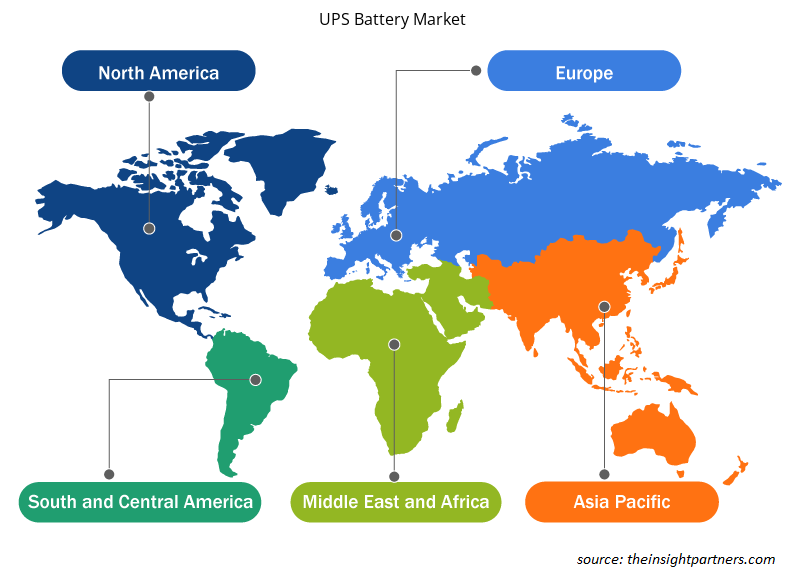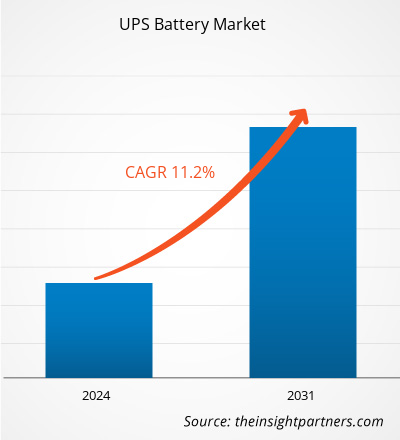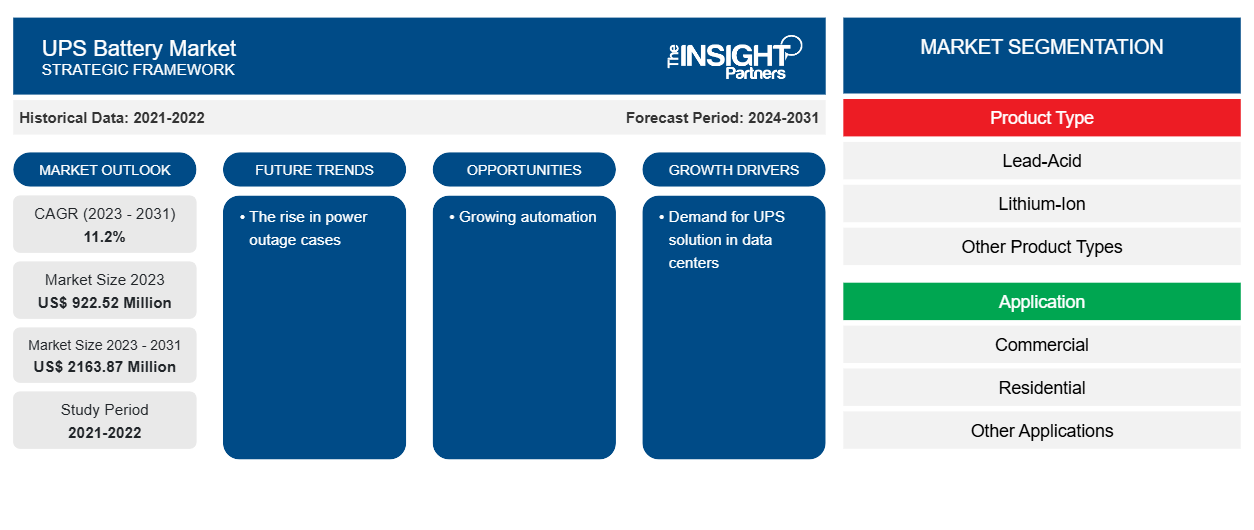UPS バッテリー市場規模は、2023 年の 9 億 2,252 万米ドルから 2031 年には 2 億 1,6387 万米ドルに達すると予測されています。市場は 2023 年から 2031 年にかけて 11.2% の CAGR を記録すると予想されています。停電件数の増加と住宅および商業部門の拡大は、今後も市場の主要なトレンドであり続けると思われます。
UPS バッテリー市場分析
企業および産業部門における大規模データセンターの建設の増加により、UPS システムの需要が生まれ、UPS バッテリー市場がさらに成長しています。ミッションクリティカルな電子機器、施設、ガジェット、重要なインフラストラクチャなどへの継続的な電力供給の必要性により、市場の成長がさらに促進されています。世界中で停電事例が増加しているため、UPS ソリューションの需要がさらに高まり、UPS バッテリー市場の成長がさらに促進されています。
UPS バッテリー市場の概要
無停電電源装置 (UPS) バッテリーまたは UPS 電源は、停電や停電の問題の際に電力貯蔵またはバックアップとして機能する電力システムの一種です。これは通常、予期しない停電により負傷、死亡、深刻な業務中断、またはデータ損失が発生する可能性があるデータ センター、コンピューター、通信機器、その他の電気機器などのハードウェアを保護するために使用されます。データ センターと産業部門の増加により、UPS バッテリーの市場成長が促進されています。
要件に合わせてレポートをカスタマイズする
このレポートの一部、国レベルの分析、Excelデータパックなど、あらゆるレポートを無料でカスタマイズできます。また、スタートアップや大学向けのお得なオファーや割引もご利用いただけます。
-
このレポートの主要な市場動向を入手してください。この無料サンプルには、市場動向から見積もりや予測に至るまでのデータ分析が含まれます。
UPS バッテリー市場の推進要因と機会
データセンターにおけるUPSソリューションの需要
UPS ソリューションは、ミッションクリティカルなデータセンター インフラストラクチャにとって重要なシステムです。UPS システムがあれば、データセンターに安定した効率的な電力を供給できます。UPS システムは、主電源がダウンしたときに大規模なデータセンターをサポートします。ユーザーは、より高いレベルのアップタイムを必要としています。この要因により、データセンターを効率的に稼働させるために電力を増やす必要性が生じます。データセンターの UPS システムは、電源が失われてから数ミリ秒以内に正確な量の電力を供給します。したがって、データセンター市場の成長は、UPS バッテリー市場の成長を促進します。
UPSバッテリーの幅広いエンドユーザー
UPS バッテリー市場の主なエンドユーザーには、商業、住宅、工業の各部門が含まれます。食品・飲料、製薬、発電所、航空宇宙は、停電や非常に高い周囲温度の可能性に囲まれた重要な産業の一部です。UPS バッテリーは UPS の主要コンポーネントであるため、UPS の優れたパフォーマンスと長い寿命に寄与します。UPS は、これらの用途以外にも、データ センター、企業、家庭用電化製品、電気機器にも使用されています。UPS の普及が進むにつれて、UPS バッテリーの範囲は拡大します。
UPS バッテリー市場レポートのセグメンテーション分析
UPS バッテリー市場分析の導出に貢献した主要なセグメントは、製品タイプとアプリケーションです。
- 製品タイプに基づいて、UPS バッテリー市場は鉛蓄電池、リチウムイオン、およびその他の製品タイプに分かれています。リチウムイオンセグメントは、最も高い CAGR で成長すると予想されています。
- 用途別に見ると、市場は商業、住宅、その他の用途に分かれています。2023年には商業分野が市場で大きなシェアを占めました。
UPS バッテリー市場シェアの地域別分析
UPS バッテリー市場レポートの地理的範囲は、主に北米、アジア太平洋、ヨーロッパ、中東およびアフリカ、南米および中米の 5 つの地域に分かれています。
アジア太平洋地域は、2023年に最大の市場シェアを占めました。データセンターの建設の増加により、電力供給の中断のない需要が生まれ、この地域のUPSバッテリー市場の成長を牽引しています。政府当局による補助金の提供と、ハイパースケールデータセンターの構築に対する市場プレーヤーの投資の増加が、市場をさらに牽引しています。住宅部門の増加が市場の成長を牽引しています。
UPS バッテリー市場の地域別分析
予測期間を通じて UPS バッテリー市場に影響を与える地域的な傾向と要因は、Insight Partners のアナリストによって徹底的に説明されています。このセクションでは、北米、ヨーロッパ、アジア太平洋、中東およびアフリカ、南米および中米にわたる UPS バッテリー市場のセグメントと地理についても説明します。

- UPSバッテリー市場の地域別データを入手
UPSバッテリー市場レポートの範囲
| レポート属性 | 詳細 |
|---|---|
| 2023年の市場規模 | 9億2,252万米ドル |
| 2031年までの市場規模 | 21億6,387万米ドル |
| 世界のCAGR(2023年~2031年) | 11.2% |
| 履歴データ | 2021-2022 |
| 予測期間 | 2024-2031 |
| 対象セグメント |
製品タイプ別
|
| 対象地域と国 |
北米
|
| 市場リーダーと主要企業プロフィール |
|
UPS バッテリー市場のプレーヤー密度: ビジネスダイナミクスへの影響を理解する
UPS バッテリー市場は、消費者の嗜好の変化、技術の進歩、製品の利点に対する認識の高まりなどの要因により、エンドユーザーの需要が高まり、急速に成長しています。需要が高まるにつれて、企業は提供を拡大し、消費者のニーズを満たすために革新し、新たなトレンドを活用し、市場の成長をさらに促進しています。
市場プレーヤー密度とは、特定の市場または業界内で活動している企業または会社の分布を指します。これは、特定の市場スペースに、その市場規模または総市場価値に対してどれだけの競合相手 (市場プレーヤー) が存在するかを示します。
UPS バッテリー市場で事業を展開している主要企業は次のとおりです。
- CSBバッテリー株式会社
- イーストペン製造会社
- イートンコーポレーション
- エクサイド インダストリーズ リミテッド
- FIAMM エネルギー テクノロジー SpA
- 株式会社ジーエス・ユアサ
免責事項:上記の企業は、特定の順序でランク付けされていません。

- UPSバッテリー市場のトップキープレーヤーの概要を入手
UPS バッテリー市場のニュースと最近の動向
UPS バッテリー市場は、主要な企業出版物、協会データ、データベースなどの一次調査と二次調査後の定性的および定量的データを収集することによって評価されます。UPS バッテリー市場の動向のいくつかを以下に示します。
- データセンター業界の無停電電源装置 (UPS) 向けエネルギー貯蔵ソリューションの世界的リーダーである C&D Technologies は、プレミアム Pure Lead Max (PLM) VRLA バッテリーを発表しました。Pure Lead Max は、C&D のラインナップの中で最も長持ちする UPS システム用 VRLA バッテリーであり、業界をリードする 8 年間の保証が付いています。(出典: C&D Technologies、プレスリリース、2023 年 3 月)
- イートンは、9PX リチウムイオン無停電電源装置 (UPS) の世界発売を発表しました。バックアップ電源ソリューションにおける革新的なリチウムイオン電池機能の提供におけるリーダーシップを基盤とするイートンの新しい UPS は、バルブ制御鉛蓄電池 (VRLA) 電池駆動の UPS 技術よりも長い電池寿命と小さな設置面積を実現し、医療から教育に至るまでの分散型「エッジ」環境や軽工業アプリケーションに最適です。(出典: イートン、プレスリリース、2021 年 7 月)
UPS バッテリー市場レポートの対象範囲と成果物
「UPS バッテリー市場の規模と予測 (2021 ~ 2031 年)」レポートでは、以下の分野をカバーする市場の詳細な分析を提供しています。
- UPSバッテリー市場の規模と予測は、対象範囲に含まれるすべての主要市場セグメントについて、世界、地域、国レベルで示されています。
- UPSバッテリー市場の動向、および推進要因、制約、主要な機会などの市場動向
- 詳細なPEST/ポーターの5つの力とSWOT分析
- UPSバッテリー市場分析では、主要な市場動向、世界および地域の枠組み、主要プレーヤー、規制、最近の市場動向を取り上げています。
- UPSバッテリー市場の市場集中、ヒートマップ分析、主要プレーヤー、最近の動向を網羅した業界の状況と競争分析
- 詳細な企業プロフィール
- 過去2年間の分析、基準年、CAGRによる予測(7年間)
- PEST分析とSWOT分析
- 市場規模価値/数量 - 世界、地域、国
- 業界と競争環境
- Excel データセット
最新レポート
関連レポート
お客様の声
購入理由
- 情報に基づいた意思決定
- 市場動向の理解
- 競合分析
- 顧客インサイト
- 市場予測
- リスク軽減
- 戦略計画
- 投資の正当性
- 新興市場の特定
- マーケティング戦略の強化
- 業務効率の向上
- 規制動向への対応























 無料サンプルを入手 - UPSバッテリー市場
無料サンプルを入手 - UPSバッテリー市場